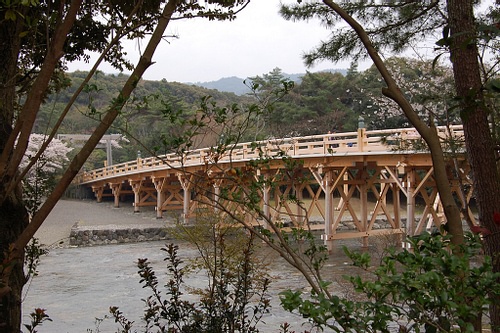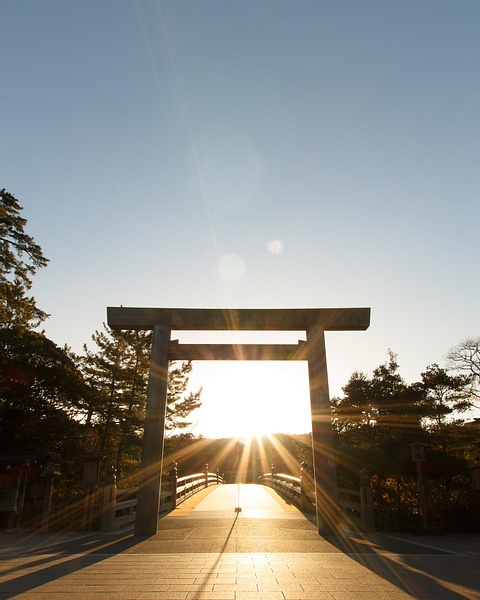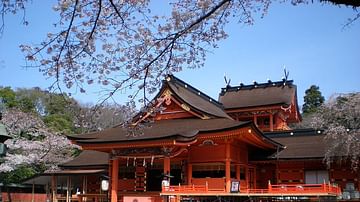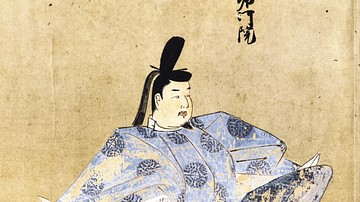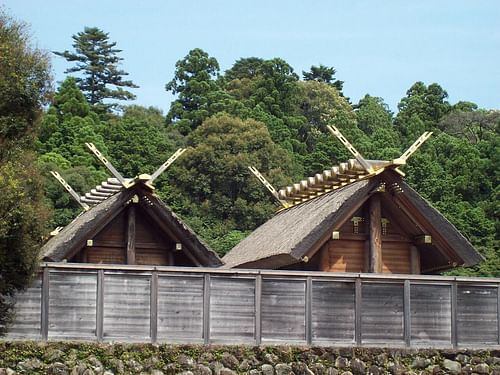
The Ise Grand Shrine or Ise Jingu, located in the heart of a sacred forest in the Mie Prefecture of Japan, is the most important Shinto shrine in the country and is dedicated to the sun goddess Amaterasu with a separate shrine dedicated to Toyouke, the food goddess. First built in 4 BCE, the present-day structures are based on the buildings erected in the 7th century CE. Uniquely, 16 of the 125 buildings at the sprawling complex, as well as the Uju bridge and torii gateway, are rebuilt exactly every 20 years, the last occasion being 2013. Ise Jingu is the ancestral shrine of the emperors of Japan.
Naiku
The Ise Jingu site is actually a double shrine, the Naiku or inner shrine and the Geku or outer shrine. There are also several smaller shrines dedicated to many other kami or Shinto spirits. The Naiku, formally known as Kotaijingu and the most important of the two, is dedicated to Amaterasu Omikami the sun goddess and supreme deity of the Shinto pantheon. The shrine was first built at the site, according to tradition, in 4 BCE during the reign of Emperor Suinin. The architectural style is yuiitsu shinmei-zukuri and copies the forms of ancient rice granary buildings. Made from cypress wood, the structure is a rectangle (with a height of 10 m / 33 ft) with a veranda and gabled roof; there are no windows. Beneath the flooring is a symbolic pole known as the shin no mihashira or 'heart pillar.'
Decorative elements of the shrine include gold-plated caps on the post ends and 33 suedama or flaming orbs along the veranda railings. The roof is made from thatch using kaya grass and the poles (chigi) of the sloping roof extend beyond the ridgepole to form a row of external V forms. There are also 10 katsuogi or short horizontal poles laid across the roof ridge at right angles. Two large columns without bases support the roof, one at each end of the structure. The whole building rests on a stilt platform 2.4 m (8 ft.) high. The entrance is at the side with a covered walkway leading to a staircase.
The most sacred object housed in the shrine, the goshintai or manifestation of the goddess Amaterasu, is the mirror (yata no jingi) which the gods had used to tempt her out of her self-imposed imprisonment in a cave following her disgust at her brother Susanoo's outrageous behaviour. The mirror is considered part of the imperial Japanese regalia (sanshu no jingi). According to tradition, it was enshrined at Ise by Princess Yamatohine (aka Yamato-hime no Mikoto) in 4 BCE after she had received a sign from Amaterasu. According to the Nihon Shoki ('Chronicle of Japan,' 720 CE), Amaterasu declared:
The province of Ise, of the divine wind, is the land whither repair the waves from the eternal world, the successive waves. It is a secluded and pleasant land. In this land I wish to dwell. (in Scott Littleton, 76)
Princess Yamatohine followed her instructions and became the shrine's first priestess (saio), beginning a long tradition of emperor's daughters taking on the role.
Geku
Almost 5 km walk through the forest from the Naiku shrine lies the Geku (aka Geigu) shrine, formally known as Toyouke Dajingu, which is dedicated to Toyouke omikami, the goddess of food, clothing, and shelter, and was traditionally founded in 478 CE during the reign of Emperor Yuryaku (456-479 CE). According to legend, the emperor had received instructions in a dream from Amaterasu to establish a shrine at the site to Toyouke who would serve the sun goddess her meals. The design of the Geku building is very similar to the Naiku shrine. Ornamentation includes 31 suedama and nine katsuogi. Enclosed by a high fence it is not possible to actually see the Geku building except the apex of its roof. As with the Naiku shrine, only senior priests and the emperor may enter inside.
Uji Bridge
The Ise Jingu shrine complex boasts over 125 other buildings besides the two main shrines. These include subsidiary shrines, purification halls (saikan), food offering preparation halls (imibiyaden), and halls for imperial visitors (anzaisho). Most impressive amongst these is the Uji Bridge which crosses the Isuzugawa river. The wooden bridge gives access to the Naiku shrine and is 102 metres (335 ft) long and 8.2 metres (27 ft) wide. At either end stand huge torii gates (7.3 m/24 ft tall), traditional markers which separate the sacred space from the outside world. Five million people cross the bridge each year.
Worship & Festivals
Worshippers purify themselves by washing in the Isuzugawa river and, visiting the shrines, they particularly offer prayers for the imperial family, Japan as a nation, and for their own needs. The very act of visiting the shrine is regarded as one of pilgrimage by followers of Shinto, and even the emperor makes an annual visit. Ise Jingu has a twice-yearly festival, the Kagura festival, held each April and September when there are performances of traditional Japanese theatre, poetry, dancing and music, as well as flower arrangement displays.
Ritual Rebuilding
Starting during the reign of Empress Jito (686-697 CE), every 20 years the Amaterasu shrine, the Toyouke shrine, 14 other buildings, the Uji Bridge and the torii gateway are all symbolically rebuilt next to the existing structures in a process known as shikinen sengu. The rebuilding programme, which takes 8 years, re-energises the power of the shrines which are built exactly to the existing designs. The pieces of the old shrines are then redistributed to shrines across Japan where they are incorporated into the walls there to instil new energy into them. 2013 was the 62nd and most recent rebuilding programme at the Ise shrine. In addition, the other structures at the complex are not entirely neglected, for 43 are rebuilt every 40 years.
All of this reconstruction, done using traditional tools and no nails, requires a massive 12,000 cypress logs, most of them from 200-year-old trees to achieve the necessary size required. The crucial ridgepoles for the two main shrines come from 400-year-old cypress trees as they must be 1.4 m (4.5 ft.) in diameter to bear the weight. When the new shrine is ready the Sengyo night ceremony sees priests transfer the most sacred shrine objects, including the goshintai, to their new home, modestly hidden in a silk drape (kingai). Besides architectural renewal, many of the site's other sacred objects are also regularly remade exactly, including jewels, costumes, swords and saddles.
This content was made possible with generous support from the Great Britain Sasakawa Foundation.
